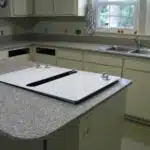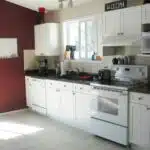As a countertop design expert, I have encountered many clients who struggle with choosing the perfect color for their countertops. Countertops are a significant investment and can significantly impact the look and feel of your kitchen or bathroom. Therefore, it is crucial to consider several factors before selecting a color that suits your style and preferences.
Choosing the right countertop color requires careful consideration of various elements such as your personal style, the existing decor in your home, and how you plan to use the space. With so many options available in the market, it can be overwhelming to settle on one specific color. However, by understanding what to look for and considering your unique needs, you can make a confident decision that will enhance the beauty and functionality of your space. In this article, we will explore some essential tips on how to choose the perfect countertop color that meets your design goals while adding value to your home.
Assessing Your Personal Style
What does your personality say about you? Color psychology plays a significant role in determining the colors that we are drawn to. For instance, if you are an outgoing person, you may be attracted to brighter colors such as red and orange. On the other hand, if you tend to be more reserved, you might prefer muted colors like beige or gray. Understanding your personality can help guide your decisions when selecting a countertop color.
Fashion inspiration is another excellent source of ideas for choosing a countertop color. Fashion trends often dictate color palettes for home décor as well. If there is a particular outfit that you love wearing, consider the colors in it and how they make you feel. If those colors evoke positive emotions, it is likely that incorporating them into your kitchen design will do the same.
Ultimately, choosing a countertop color comes down to personal preference. However, understanding your personality and drawing inspiration from fashion trends can help narrow down your choices. Identifying what appeals to you visually and emotionally is crucial in creating a space that makes you feel comfortable and happy every day. In the next section, we will delve deeper into how to identify your color preferences and translate them into an ideal countertop color choice.
Identifying Your Color Preferences
When it comes to choosing a countertop color, the first step is to identify your color preferences. One way to do this is by understanding color psychology. Different colors can evoke different emotions and moods, so it’s important to consider how you want your kitchen or bathroom to feel. For example, if you want a calming and relaxing atmosphere, you may want to choose a cool tone like blue or green. On the other hand, if you want a bold and energetic space, you may opt for a warm tone like red or orange.
Another factor to consider when identifying your color preferences is current color trends. While it’s important to choose a color that speaks to your personal style, it’s also helpful to stay up-to-date with current trends in countertop design. For instance, neutral colors like gray and beige have been popular choices in recent years because they offer versatility and timeless appeal.
Ultimately, the key is finding a balance between your personal preferences and what works best for your space. By taking into account both color psychology and current trends, you can narrow down your options and make an informed decision that will enhance the overall look and feel of your home.
Transition: Now that you have identified your color preferences based on psychology and trends, the next step involves considering the existing decor in your home.
Considering The Existing Decor In Your Home
- When choosing a countertop color for your existing decor, it is important to consider both matching and coordinating with existing colors.
- Matching existing colors can help to create a cohesive look, while coordinating with wall colors can add contrast and visual interest.
- To match existing colors, select a countertop color that is the same hue as the existing materials in the room.
- To coordinate with wall colors, select a countertop color that is either a lighter or darker version of the wall color, depending on the desired look.
Matching Existing Colors
Matching existing colors is a crucial aspect when choosing the right countertop color for your home. Color psychology plays a vital role in determining how certain colors affect our mood and emotions. For instance, warm colors such as red, orange, and yellow evoke feelings of energy, excitement, and happiness. On the other hand, cool colors like blue and green create a calming effect that promotes relaxation and tranquility.
Cultural influences also play a significant role in color choices. Different cultures have their unique meanings attached to different shades of color. For instance, in Chinese culture, red symbolizes good luck and prosperity. Therefore, incorporating red into your kitchen countertops can be an excellent way to bring positive energy into your home.
When selecting countertop colors that match existing decor in your home, it is essential to consider the undertones of the existing hues. Generally, there are three main undertones: warm (yellow or gold), cool (blue or gray), or neutral (beige or taupe). Choosing a countertop with undertones that complement those of your furniture and wall paint will give your home a cohesive look that feels put together.
In conclusion, matching existing colors is an integral part of choosing the perfect countertop color for your home. Understanding color psychology and cultural influences can help you make informed decisions that promote positive emotions and energy flow in your space. Considering undertones when selecting countertop colors ensures that they blend seamlessly with existing decor elements to achieve a polished look in your home’s design scheme.
Coordinating With Wall Colors
When designing a kitchen, it is essential to consider the existing decor in your home. Coordinating your countertop color with the wall colors is an effective way to achieve a cohesive look. Wall color coordination helps create harmony and balance in your space while enhancing the overall design aesthetic.
Color psychology plays a crucial role in coordinating wall colors with countertop colors. Certain hues evoke specific emotions and can affect our mood differently. Warm tones such as red, orange, and yellow create an energetic and lively atmosphere, while cool tones like blue and green bring a sense of calmness and tranquility. Understanding these color associations can help you select the right countertop color that complements your wall paint.
When coordinating wall colors with countertop colors, it is important to pay attention to the undertones of each hue. Undertones are subtle hues that influence the overall appearance of a color. For instance, beige paint may have warm or cool undertones that can clash with certain countertop colors if not considered carefully. Therefore, choosing a countertop color with undertones that complement those of your wall paint will ensure that both elements blend seamlessly together for a polished look.
In conclusion, coordinating countertop colors with wall colors is an integral aspect of designing a kitchen that feels put together. Taking into account color psychology and undertones when selecting these elements will ensure they complement each other effectively for an aesthetically pleasing result. By following these guidelines, you can create a space that promotes positive energy flow while reflecting your personal style preferences.
Matching Countertop Color With Your Cabinets
Considering the Existing Decor in Your Home is an important factor when choosing a countertop color. You want to make sure that your new countertops match the overall design aesthetic of your home. If you have a modern or minimalist style, choosing a bold and contrasting countertop can add interest to the space. On the other hand, if your home has a traditional or classic look, choosing a neutral and timeless countertop color will create a cohesive look.
Matching Countertop Color with Your Cabinets is another critical factor to consider when selecting the perfect countertop color. It’s crucial to choose colors that complement each other rather than compete for attention. If you have cabinets with a warm tone, selecting cool-toned countertops will provide a nice contrast and vice versa. Additionally, Contrasting finishes between your cabinets and countertops can add depth and dimension to your kitchen.
Creating a Cohesive Look is vital in making sure that all elements of your kitchen work together seamlessly. If your home has an open floor plan, it’s essential to ensure that all areas flow effortlessly into one another. This can be achieved by using similar colors or materials throughout the space. By doing this, you can create visual continuity and make your kitchen feel more spacious and inviting.
3 ways to evaluate your lighting situation
- Assess the amount of natural light in your kitchen as it can affect how colors appear.
- Consider installing under-cabinet lighting to highlight the beauty of your new countertops.
- Experiment with different types of bulbs to find one that enhances the chosen color scheme while providing ample illumination for cooking and dining areas.
As you prepare to choose the perfect countertop color for your kitchen renovation project, remember that evaluating lighting conditions is just as crucial as considering existing decor or matching colors with cabinets. By following these simple steps, you’ll be well on your way to creating an inviting space that meets both form and function requirements- ensuring maximum enjoyment for years to come!
Evaluating Your Lighting Situation
When it comes to choosing the right countertop color, evaluating your lighting situation is crucial. The way light interacts with different colors can significantly affect how they appear in a room. As a countertop design expert, I recommend taking note of the placement of your lighting fixtures and any natural light sources in the area where you plan to install your new countertops.
Lighting placement plays a significant role in how colors are perceived. For instance, if you have overhead lighting that casts shadows on your countertops, this can make darker colors appear even darker and create an unappealing contrast. On the other hand, if you have under-cabinet lighting, this can highlight lighter-colored countertops and create a warm ambiance. Similarly, natural light sources such as windows or skylights can affect how colors look throughout the day and in different seasons.
To get an idea of how different countertop colors will look in your space, it’s best to observe them at different times of day and under various lighting conditions. You can also bring home samples of your top choices and place them near your lighting fixtures to see how they interact with each other. By taking these steps and considering the impact of your lighting situation on countertop color choices, you’ll be well on your way to creating a beautiful and functional kitchen or bathroom space.
As you evaluate your lighting situation when choosing a countertop color, it’s essential to keep in mind that different colors will have varying levels of reflectivity. Lighter colors tend to reflect more light than darker ones, making them ideal for spaces without much natural light. If you have plenty of natural light sources but still want a darker color for your countertops, consider one with some reflective qualities or opt for a glossy finish that will catch more light. With these factors in mind, determining the right countertop color for your needs becomes much easier.
Determining Your Budget
Did you know that the average cost of a kitchen remodel ranges from $13,000 to $37,000? This demonstrates how crucial it is to set your budget before starting your countertop selection process. Setting priorities and researching pricing will help you stay on track with your budget.
Firstly, determine what aspects of your kitchen are most important to you. Do you value aesthetics over functionality? Or perhaps durability is a top priority for you. Understanding what matters most to you will help guide your decision-making process and ensure that you allocate funds accordingly.
Once priorities have been set, research pricing for different countertop materials within those categories. For example, if durability is important to you, consider materials such as quartz or granite. It’s essential to not only research the upfront costs but also the long-term maintenance and repair costs associated with each material. By doing so, you’ll be able to make an informed decision that fits within your budget without sacrificing quality or style.
In summary, determining your budget is essential when selecting a countertop color. Setting priorities and researching pricing are crucial steps in staying within your budget while ensuring that your chosen material aligns with both your functional and aesthetic preferences. In the next section, we’ll dive into selecting a material based on your lifestyle needs and design preferences.
Selecting A Material
When it comes to choosing the right countertop material, there are several factors to consider. One key consideration is your budget. If you’re looking for cost-effective options, materials like laminate or ceramic tile may be the way to go. These materials can mimic the look of more expensive options like marble or granite, but at a fraction of the cost.
Another factor to consider when choosing a countertop material is eco-friendliness. Many homeowners are opting for sustainable options like recycled glass or bamboo. These materials not only offer an environmentally conscious choice, but they also add unique style and texture to your kitchen or bathroom.
It’s important to note that durability should also be taken into account when selecting a countertop material. In the next section, we’ll examine how different colors can affect the longevity of your countertops. By considering all these factors and consulting with a design expert, you’ll be able to choose the perfect countertop material that fits both your functional needs and aesthetic preferences.
Examining The Durability Of Different Colors
Scratch Resistance is an important factor to consider when selecting a countertop color; some materials such as quartz and granite resist scratches better than others. Heat Resistance should also be taken into account, as certain colors may be more vulnerable to heat damage. Stain Resistance is also a key factor to consider, as some colors are more prone to staining than others. Impact Resistance is another important factor, as certain colors may be more susceptible to chipping or cracking than others.
Scratch Resistance
When it comes to selecting a countertop color, scratch resistance is an important factor to consider for those who want to ensure their countertops remain in pristine condition. It’s crucial to distinguish between polished and matte finishes since each has its pros and cons. Polished finishes are more prone to scratches, while matte finishes tend to hide them better. However, darker colors also have the advantage of hiding scratches more effectively than light-colored ones.
Polished finishes are ideal for people who prioritize aesthetics over durability. They give off a sleek and modern look that can elevate any kitchen design. However, they can be challenging to maintain since they show scratches more quickly than other finishes. On the other hand, matte finishes are perfect for homeowners who prefer low maintenance countertops with excellent scratch resistance. Matte surfaces don’t reflect as much light as polished ones, making them less noticeable when scratches occur.
When selecting a countertop color based on scratch resistance, it’s essential to consider dark shades like black or dark gray over lighter tones such as white or beige. Darker colors inherently hide scratches better than lighter colors due to their ability to absorb light rather than reflect it. However, this doesn’t mean that you can’t choose a lighter color if you prefer one over darker shades; it just means that you’ll need to take extra precautions in terms of upkeep and maintenance. Ultimately, the color choice depends on your personal preference and lifestyle needs.
Heat Resistance
When it comes to selecting a countertop, durability is a significant factor that should not be overlooked. In addition to scratch resistance, heat resistance is another essential element that can determine the longevity of your countertops. Choosing heat resistant materials is crucial if you want your countertops to withstand high temperatures without cracking or discoloring. As a countertop design expert, I recommend testing heat resistance before making any final decisions.
There are various materials available on the market that offer excellent heat resistance, such as granite, quartz, and porcelain. However, each material has its pros and cons. Granite is highly durable and can withstand high temperatures without any issues. Quartz, on the other hand, is non-porous and requires less maintenance than granite but may not tolerate extreme heat as well as granite does. Porcelain is also an excellent choice for those who want a non-porous material with exceptional heat resistance.
When selecting a countertop color based on heat resistance, it’s essential to consider darker colors over lighter tones since darker shades absorb more light and heat than lighter ones. Additionally, it’s important to avoid placing hot pots or pans directly on the surface of your countertops since this can cause damage regardless of their level of heat resistance. By choosing the right materials and following proper care instructions, you can ensure that your countertops remain in optimal condition for years to come.
Checking For Maintenance Requirements
When choosing a countertop color, it is important to consider the maintenance requirements of each option. There is often a trade-off between cost and maintenance, as higher-end materials may require more upkeep. It’s important to weigh the initial cost of the countertop against its long-term maintenance needs.
Stain resistance is another factor to consider when selecting a countertop color. Some materials, such as granite and quartz, are highly resistant to stains while others, such as marble and concrete, are more prone to staining. If you have young children or tend to be messy in the kitchen, it may be worth investing in a material that is more stain-resistant.
Overall, it’s important to find a balance between your desired aesthetic and practical needs. While you may love the look of a particular countertop material or color, it may not be realistic for your lifestyle or budget. By considering factors such as cost vs. maintenance and stain resistance, you can make an informed decision that will serve both your aesthetic preferences and functional needs. In the next section, we will discuss how to complement your appliances with your countertop choice without sacrificing style or functionality.
Complementing Your Appliances
Appliance finishes play a crucial role in choosing the right countertop color. It is important to consider the color and texture of your appliances before selecting the countertop shade. If you have stainless steel appliances, it is best to go for countertops that complement their metallic finish. Similarly, if you have black or white appliances, it is advisable to choose a countertop color that matches or contrasts with them.
Contrasting colors can create an attractive visual appeal in your kitchen design. For instance, if you have dark-colored cabinets and light-colored appliances, consider choosing a contrasting countertop color to make the space pop. On the other hand, if you have lighter cabinets and darker appliances, selecting a neutral shade or matching color for your countertop may be preferable.
When complementing your appliances with countertop colors, there are several factors to keep in mind. Firstly, ensure that the shades do not clash with each other but rather enhance one another. Secondly, decide whether you want your appliances or countertops to be the focal point of your kitchen design. Finally, make sure that the overall look is cohesive and aesthetically pleasing by balancing bold and neutral colors.
As we move towards balancing bold and neutral colors for our kitchen design, it’s important to remember that this step requires careful consideration of various elements beyond just appliance finishes. By mixing different shades of neutrals such as whites, grays and beiges along with bold colors like blue or green can create contrast while maintaining balance. Let’s dive deeper into this technique in the next section.
Balancing Bold And Neutral Colors
When choosing a countertop color, it is important to consider the balance between bold and neutral tones. Bold colors can add excitement and personality to a space, but they may also become overwhelming if used excessively. On the other hand, subtle tones offer a calming effect and can complement bolder accents in the room. To achieve a balanced look, incorporate both bold and neutral shades into your overall design.
Another factor to consider is the balance between warm and cool hues. Warm tones such as reds, oranges, and yellows can create a cozy atmosphere in a kitchen or bathroom, while cool tones like blues and greens promote relaxation. It’s important to choose colors that harmonize with the rest of your decor and personal preferences. Experimenting with different combinations of warm and cool hues can help you find the perfect balance for your countertop.
In summary, balancing bold vs subtle tones and warm vs cool hues is key when selecting a countertop color. Consider incorporating both elements into your design to achieve an optimal balance. In doing so, you’ll be able to create a cohesive look that complements your personal style while also serving practical purposes in your home. Next up, we’ll explore how to choose between solid colors or patterns for your countertop design.
Choosing Between Solid Colors Or Patterns
When it comes to countertops, one of the most important decisions you’ll make is whether to go with solid colors or patterns. Both options have their advantages and disadvantages, so it’s important to weigh your priorities carefully before making a decision.
Solid colors are a great choice if you’re looking for a clean, minimalist look in your kitchen or bathroom. They can also be easier to match with other elements in the room, such as tile backsplashes or cabinet finishes. One potential disadvantage of solid colors is that they may show stains more easily than patterned surfaces, especially if you choose a light color. Additionally, if you’re concerned about resale value, keep in mind that some buyers may prefer more ornate patterns over simple solids.
On the other hand, patterns can add visual interest and texture to your space. They can also help hide stains and scratches better than solid colors. However, some homeowners may find that too much pattern can be overwhelming or distracting in a small space. Additionally, if you choose an unusual or trendy pattern, it could potentially impact your home’s resale value negatively if future buyers don’t share your taste.
When deciding between solids and patterns for your countertop color, consider factors like your personal style preferences and how much time you’re willing to spend on maintenance. Ultimately, there’s no right or wrong choice – it all comes down to what works best for your lifestyle and design vision.
Incorporating natural stone into your countertop design is another option worth considering. Natural stone offers unique variations in texture and color that can give your space an organic feel. We’ll explore this option further in the next section.
Incorporating Natural Stone
Like a master painter selecting colors for their canvas, choosing the right natural stone for your countertop can be an exhilarating experience. Natural stone countertops have been a staple in kitchen and bathroom designs for centuries, and it’s no secret why they continue to be popular today. Natural stone benefits include its durability, beauty, and unique patterns that are unparalleled by other materials.
When it comes to incorporating natural stone into your design scheme, there are several options available. Granite is one of the most popular choices due to its durability and resistance to scratches and heat. Marble is another choice that adds elegance and luxury to any room but requires more maintenance than granite. Quartzite is a harder material than granite or marble, making it ideal for high traffic areas like kitchens. Other alternatives to natural stones include engineered quartz or porcelain slabs that mimic the look of natural stones without the upkeep.
While there are numerous options for incorporating natural stone into your home, it’s essential to choose a color scheme that complements your overall design aesthetic. Using samples to visualize the end result can help you make an informed decision about which natural stone will best suit your needs. By doing so, you’ll create a space that not only looks great but also functions efficiently for years to come.
Using Samples To Visualize The End Result
- When selecting a countertop color, it is important to view the sample in natural light to ensure the best representation of the final result.
- Additionally, it is important to take into consideration the colors of the surrounding cabinetry, flooring, and walls to ensure the countertop complements the overall design.
- Furthermore, it is beneficial to compare different materials when selecting a countertop, as each material will have a unique look and feel.
- Understanding the available finishes for each material is important in order to ensure the desired color is achieved.
- Considering how color and texture can change when exposed to different lighting conditions can help to make an informed decision when selecting a countertop.
- Overall, it is important to remain aware of the surrounding colors and materials, and to always view samples in natural light in order to visualize the end result.
Viewing Samples In Natural Light
The importance of choosing the right color for your countertop cannot be overstated. It can make or break the overall look and feel of your kitchen or bathroom. One of the key aspects to consider when selecting a countertop color is viewing samples in natural light. This is because natural light offers advantages that artificial light simply cannot provide.
When selecting a countertop color, it is essential to view samples in natural light as it allows you to see the true colors and undertones. Natural light enhances the subtleties of a color, allowing you to determine whether it complements or clashes with other elements in the room. In contrast, artificial light can mask certain colors, making them appear different from their true hue. Therefore, taking advantage of natural light’s benefits will give you a better idea of what your finished space will look like.
Moreover, viewing samples in natural light helps you avoid any regrets after installation. Sometimes a color may look perfect under artificial lighting but appear entirely different in natural daylight. By choosing your countertop color through natural lighting, you are ensuring that it looks great at all times throughout the day. In conclusion, taking advantage of natural lighting when selecting a countertop color provides significant advantages over relying solely on artificial lighting.
Considering The Surrounding Colors
When it comes to choosing the right countertop color, it is essential to use samples to visualize the end result. However, simply looking at a sample in natural light is not enough. Another crucial aspect to consider is the surrounding colors in the room. As a countertop design expert, I highly recommend taking color psychology and coordinating with wall colors into account when selecting your countertop color.
Color psychology plays a significant role in how we perceive our surroundings. Certain colors evoke specific emotions and can affect our mood and behavior. Therefore, it is crucial to consider the impact of your countertop color on the overall atmosphere of your kitchen or bathroom. Coordinating with wall colors is another essential factor to consider as it ensures that your countertop complements rather than clashes with other elements in the room.
In conclusion, using samples to visualize the end result of your countertop involves more than just viewing them in natural light. As an expert in countertop design, I highly recommend considering color psychology and coordinating with wall colors when selecting your countertop color. By doing so, you can create a space that not only looks great but also evokes positive emotions and reflects your personal style.
Comparing Different Materials
When it comes to selecting the perfect countertop, using samples is a crucial step in visualizing the end result. However, it is essential to go beyond just looking at samples in natural light and consider other factors that can affect the overall aesthetic of the space. One of these factors is comparing different materials. Each material has its unique set of characteristics, such as durability, maintenance requirements, and cost.
As a countertop design expert, I highly recommend comparing different materials to determine which one best suits your needs. Consider factors such as the color psychology and trending colors for each material. For example, quartz countertops come in a wide range of colors and patterns that can complement any interior design. On the other hand, granite countertops offer a natural look and feel that adds warmth and elegance to any space.
In addition to considering color psychology and trending colors, it is essential to compare different materials’ pros and cons. This will ensure that you choose a countertop that not only looks great but also meets your functional needs. By taking the time to compare different materials thoroughly, you can make an informed decision that will result in a beautiful and functional space.
Seeking Professional Design Assistance
Benefits of Design Assistance
Choosing the right color for your countertop can be overwhelming, especially with all the options available. One of the benefits of seeking professional design assistance is that you’ll have access to a trained eye that can help you narrow down your choices. A reputable designer can guide you through the selection process and recommend colors that are both aesthetically pleasing and functional.
Another benefit of working with a designer is that they can provide you with samples and swatches to help you visualize how different colors will look in your space. This is especially helpful if you’ve already chosen other elements, such as cabinets or flooring, which will impact how your countertop color will appear. A designer can also provide insight into complementary colors and finishes that will enhance the overall look of your kitchen or bathroom.
When choosing a reputable designer, it’s important to do your research. Look for designers who have experience working with countertops specifically, as this requires a unique skill set. Read reviews from previous clients to get an idea of their level of expertise and customer service. Don’t be afraid to ask for references or examples of their work to ensure they’re the right fit for your project.
Remember, investing in professional design assistance can ultimately save you time, money, and stress in the long run. By working with a knowledgeable expert, you’ll feel more confident in your selection and love the end result for years to come.
Conclusion
Choosing the right countertop color can be a daunting task for homeowners. There are several factors to consider, from personal style and color preferences to the existing decor in your home. Matching the countertop color with your cabinets and evaluating your lighting situation are also important considerations. Additionally, you may need to choose between solid colors or patterns and incorporate natural stone into your design.
One interesting statistic to note is that according to a survey by Houzz, 43% of homeowners opt for neutral colored countertops while 21% prefer white countertops. This indicates that many homeowners prefer a more subdued look when it comes to their kitchen countertops. However, it’s important to remember that ultimately the decision should reflect your personal style and taste.
As a countertop design expert, I recommend seeking professional design assistance if you’re feeling overwhelmed or unsure about your choices. It’s always helpful to have an expert eye to guide you through the process and ensure that you make the best decision for your home. In addition, utilizing samples is a great way to visualize the end result and ensure that you’re happy with your choice before making any final decisions. By considering all of these factors, you’ll be able to choose a countertop color that perfectly reflects your personal style and enhances the overall look of your home.
Image Credits
- “Almost color-matched my coffee to the countertop!” by RichSPK (featured)




























